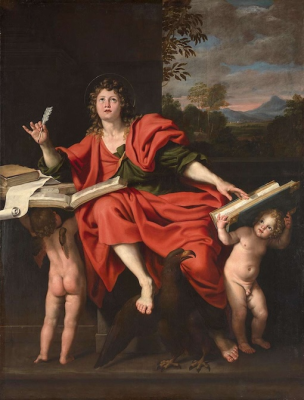Gospel in Art: Feast of Saint John, Apostle and Evangelist

St John the Evangelist, by Domenichino © Private Collection / Wikimedia
Source: Christian Art
Gospel of 27 December 2024
John 20:2-8
On the first day of the week, Mary Magdalene ran and went to Simon Peter and the other disciple, the one whom Jesus loved, and said to them, 'They have taken the Lord out of the tomb, and we do not know where they have laid him.' So Peter went out with the other disciple, and they were going towards the tomb. Both of them were running together, but the other disciple outran Peter and reached the tomb first. And stooping to look in, he saw the linen cloths lying there, but he did not go in. Then Simon Peter came, following him, and went into the tomb. He saw the linen cloths lying there, and the face cloth, which had been on the head of Jesus, not lying with the linen cloths but folded up in a place by itself. Then the other disciple, who had reached the tomb first, also went in, and he saw and believed.
Reflection on the painting
Within our Christian tradition, the four gospels hold a place of utmost significance. This is why we stand for the gospel reading, introduce it with the singing of the Alleluia, and, during solemn Masses, incense the Lectionary or Book of the Gospels. Through these actions, we acknowledge that the Lord is uniquely present to us through the gospels. Today, we celebrate the feast of the author of the fourth gospel, traditionally identified as John, one of Jesus' closest disciples. The portrait of Jesus in this gospel has a luminous and transcendent quality, as though he is transfigured on every page, not just in a single scene as in the other gospels.
Fittingly, the gospel reading for today's feast is an Easter gospel, where Mary of Magdala, Peter, and the beloved disciple are present. The repeated mention of running in this gospel reading is striking. When Mary Magdalene discovered the empty tomb on that first Easter morning, she ran to inform Simon Peter and the disciple Jesus loved. These two then ran together to the tomb, with the beloved disciple arriving first. Their running reflects the initial confusion and urgency of that moment. Jesus' body, laid in the tomb two days earlier, was now missing. Mary assumed it had been taken or stolen. While Simon Peter's thoughts are not mentioned, it is said of the beloved disciple that, upon seeing the empty tomb, he believed. This clarity of belief permeates through every page of his Gospel writings.
In our mid 17th century painting by Domenichino, Saint John the Evangelist is portrayed as a youthful figure, accompanied by his traditional symbol, the eagle, and two putti, exuding a sense of divine inspiration. His upward gaze towards God reflects his reception of the Gospel message, highlighted by the dramatic chiaroscuro lighting. He is almost floating, rather than seated. The composition draws inspiration from classical sculpture, notably The Laocoön. Note the beautiful landscape in the background, another typical aspect of Domenichino's painting. X-rays have revealed that initially, the landscape was more compressed, but Domenichino expanded it, softening the architectural dominance. Other adjustments, visible in the books, the putto's hand, and the hill in the background, reveal the artist's evolving vision for this remarkable composition.
LINKS
Gospel in Art: https://christian.art/
Today's Reflection: https://christian.art/daily-gospel-reading/john-20-2-8-2024/


















